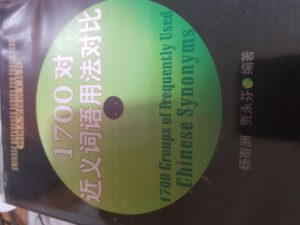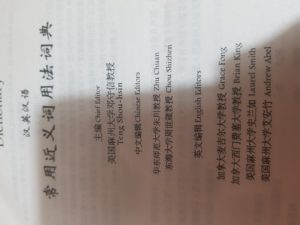Translating Synonyms
In this article, I’ll talk about synonyms in general. Then we’ll give some examples and talk about synonyms in Chinese. Finally we will talk about translating synonyms.
What are synonyms
According to the Cambridge English Dictionary, synonyms are “a word or phrase that has the same or nearly the same meaning as another word or phrase in the same language”.
So in English for example:
“Word A”, might be a synonym to another word, “Word B”. It follows that “Word B” will also be a synonym of “Word A”. In this case Word A and Word B are synonyms.
Examples of synonyms
There are huge number of synonyms in every language I am aware of. In fact there does not appear to be a single language which doesn’t include at least one synonym. Be aware that some words have more than one definition, and only one definition may be a synonym with the second word. Some random examples:
hi – hello
power – force
well – good
love – passion
important – significant
okay – fine
evidence – proof
Chinese synonyms
Chinese uses the word “近义词” (jinyici – “close meaning word”) to mean synonym, but interestingly, the word itself is different. The Chinese word literally translates to “close meaning word” rather than the exact match which would be “identical meaning word”. Quite an interesting difference.
Chinese is more liberal about differences in meaning. Broadly speaking, as a Chinese to English translator, one of the things I’ve noticed over the years is that Chinese readers are more tolerant of vague and unclear meanings and will look for possible logical or pragmatic interpretations, whereas an English reader often requires more detail and will be put off, or stop reading when they find those same unclear meanings.
As a foreign learner of Chinese, it’s worth spending time learning lots of synonyms, I can recommend two good books on the subject, but I’m sure there are a lot more out there.
17000 Groups of Frequently Used Chinese Synonyms

Chinese Synonyms Usage Dictionary

I find both books very useful and refer to them regularly. 1700 Groups of Frequently Used Chinese Synonyms has a clearer layout and gives concise logical examples. Chinese Synonyms Usage Dictionary is also a good book but it feels to me that the examples can be overly complex and sometimes distract from the key differences at hand.
Synonyms Across Languages
We’ve talked about synonyms within one language, how about having a word in French say, being a synonym for another word in German. In other words, can two words which express a similar meaning in different languages be considered synonyms. Strictly speaking the obvious answer is no, as the definition above precludes this, but we can define words however we wish and there is nothing to stop us using the word synonym instead to mean: “a word or phrase that has the same or nearly the same meaning as another word or phrase in another language.” However, it is easier to simply use the terminology “equivalent term” which is generally considered best practice in translation studies.
Translating Synonyms with Equivalent Terms
Let’s say one possible meaning of Word A in language A is a synonym with word B in language A. This does not mean that an equivalent term for Word A, which I’ll call A1 in language A is synonymous with an equivalent term for Word B in language B.
It’s probably easier to show this with some tables:
| Language A | Language B |
| English | Chinese |
| My Country | 我国 (lit. My Country) |
| Synonyms in Language A for “My Country” | |
| A1. England | A2. The UK |
| Synonyms in Language B for “我国“ | |
| B1. 中国 (Lit. China) | B2. 中华人民共和国 (Lit. People’s Republic of China) |
Comparing the synonyms. A and B can be said to be equivalent, or we could say they are synonyms. However, “England” and “中国” are clearly different.
So, while A may be a synonym of B, we can see that A1 is not necessarily equal to B1. B2 and A2 may also not be equivalent, along with B1 and A2 and vice versa.
This fact is a source of great challenges for translators, because it’s rare to see a word used only in one sense. When we translate, we may only be able to find a word which matches one sense of the word, losing potential irony, humour, additional information, or implied meaning. For legal and technical documents, it’s a particular problem, because it can cause the loss of specific detail or technical information.
In this example, the word is technically a “reference”, that is, the term is being used to refer to a specific thing, and the things being referred to are different for the two words. There are also other types of synonym.
Consequences for Translators when Translating Synonyms
1. Translating synonyms is great practice for translators
When faced with a difficult term to translate, it’s worth asking ourselves about some synonyms of the words in our source language (perhaps you could list them as an exercise). Then we can consider the synonyms for the possible candidate translations. Sometimes looking at how the synonyms overlap can give a good insight to the most appropriate target term or at least open some avenues of thought.
2. Translating synonyms is where translation theory becomes important
Broadly, there are three common approaches that I use. You can:
- Choose a word that only has the required synonyms or even remove some units of meaning. (Change “my country” to China, even though technically it would be “England” since we are speaking English to English readers in our translation)
- Add extra words to explain or define something. This could be done within the text, or even as a footnote or translator’s comment. (For example, he visited my country (*note: the author is Chinese) for the first round of business negotiations)
- Define the information elsewhere so it is clear what is being referred to. (In my example about My Country and China, if we made it clear the writer was in China and “speaking Chinese”, we could then use “My Country”)
The choices are not a matter of choosing the “right” solution. We have to weigh up all the various factors. What document is the client needing? Who will be reading it and when. Will the reader know this is a translation? Do I need to retain the style of the original, and if so how much? Balancing all the various factors is a complex art that produces the best results, although every reader will have their own preference and sadly there’s no one way that will please everybody.
I’ve written some other articles about grammar and linguistics. Have a look here to see my article about idioms.